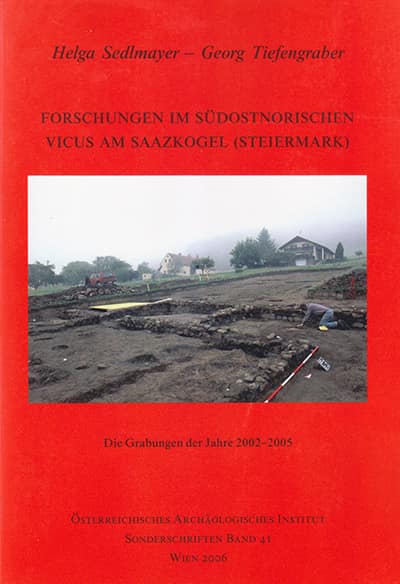Sonderschriften Band 41
328 pp, b/w figures, 36 b/w plates, pb, in German.
The roman vicus at the Saazkogel represents with an expansion of about 9 ha one of the largest so far well-known Roman settlements in eastern Styria, beside the vici of Gleisdorf and Kalsdorf it can however be designated as one of the best investigated vici in southeast Noricum. Based on the results of the excavations of 2002 to 2005 and an approximately surface covering geographical investigation a detailed overall view of the settlement can be sketched. Without a doubt the plant of the settlement is due to the traffic-geographically position at the inlet of the Saaz- into the Raab-valley. Here the road in the Raab-valley, which connected Savaria-Szombathely over the vicus of Gleisdorf with central Noricum, meets the southwest road from Flavia Solva. If one regards the structure of the vicus of Saaz, then its pronounced multipartness is noticeable including the entire hill. The settlement can be pursued at the south slope of the Saazkogel on a length of at least 600 m with a gravelled slope-parallel road. North and south this road group building complexes of different size, but very similar in the sketch on artifical terraces. Approximately in the centre of the settlement the greographical prospection shows a larger place-like open space. In the western part the road is flanked by graves, under expanded grave districts were remainders of older buildings of graves, which are probably to be assumed as building in hill graves. This ensemble from actual settlement and grave road with hill graves and younger monumental buildings of graves in Roman manners is to be confronted to the large hill grave field at the north slope of the Saazkogel. The oldest settlement horizon of the Flavian-Traianic period is characterized by timber constructions. The development in stone and the associated restructuring of the settlement with a system of property units oriented uniformly in slope drop direction is to be accepted in the Hadrianic period. This development can be well compared with further findings in southeast Norican settlements (Kalsdorf, Gleisdorf). The typical living and work building of this period is the one-and/or multi-space house in an enclosure. The abandonment of these structures and a new beginning of the activities toward the end of the 2nd century A.D. is to be pointed out in Saaz on the basis of the findings in different settlements sections. This break of the settlement development ist so far not to be seized in a comparable clarity in the neighbouring vici, but shown exclusively with the necessary distinctiveness in the urban centre of the region, Flavia Solva, by a horizon of destruction of the Markomannic Wars. In Saaz the significant findings of a destruction by force, are missing, the reasons for a break of the settlement development could nevertheless be brougth in connection with social and economic injury of wartime situations. With the new settlement activity toward the end of the 2nd century A.D. is to be seized a last prospering. A shift of the settlement emphasis led in further consequence to a cease of the use during the middle decades of the 3rd century A.D.



